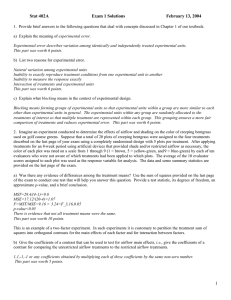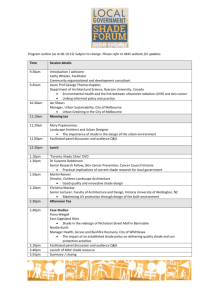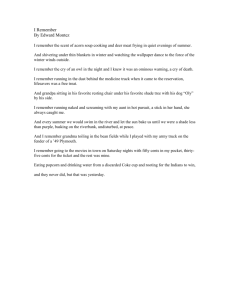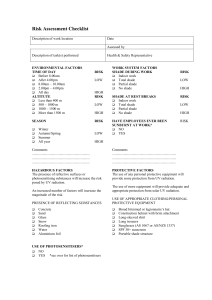Document 10639532
advertisement
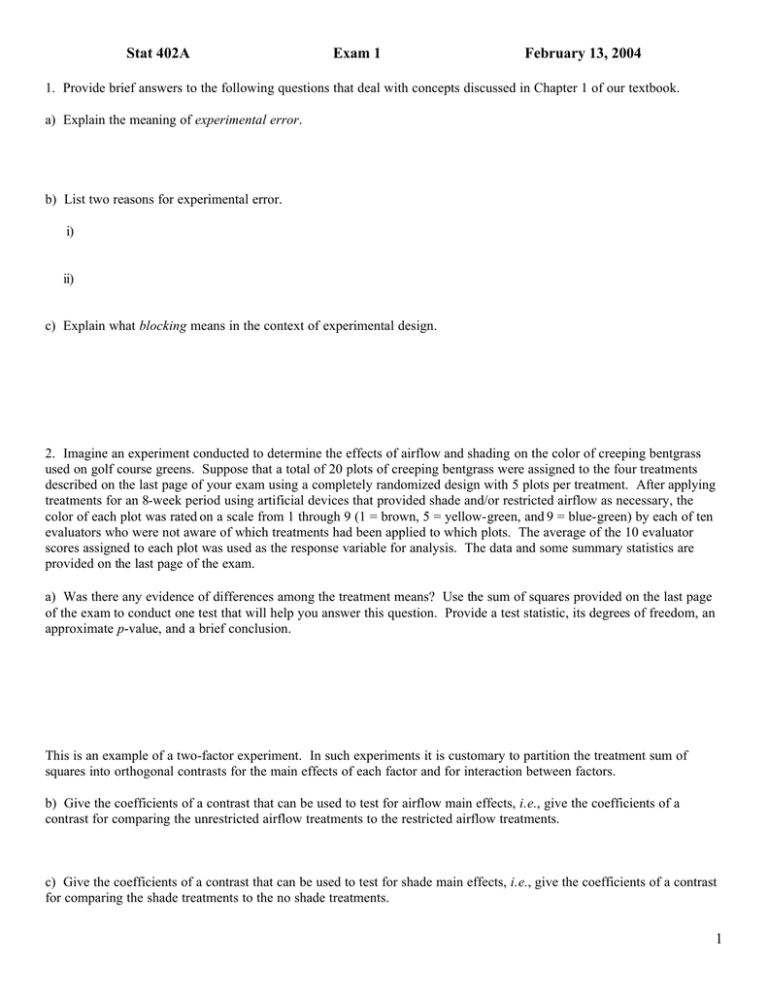
Stat 402A Exam 1 February 13, 2004 1. Provide brief answers to the following questions that deal with concepts discussed in Chapter 1 of our textbook. a) Explain the meaning of experimental error. b) List two reasons for experimental error. i) ii) c) Explain what blocking means in the context of experimental design. 2. Imagine an experiment conducted to determine the effects of airflow and shading on the color of creeping bentgrass used on golf course greens. Suppose that a total of 20 plots of creeping bentgrass were assigned to the four treatments described on the last page of your exam using a completely randomized design with 5 plots per treatment. After applying treatments for an 8-week period using artificial devices that provided shade and/or restricted airflow as necessary, the color of each plot was rated on a scale from 1 through 9 (1 = brown, 5 = yellow-green, and 9 = blue-green) by each of ten evaluators who were not aware of which treatments had been applied to which plots. The average of the 10 evaluator scores assigned to each plot was used as the response variable for analysis. The data and some summary statistics are provided on the last page of the exam. a) Was there any evidence of differences among the treatment means? Use the sum of squares provided on the last page of the exam to conduct one test that will help you answer this question. Provide a test statistic, its degrees of freedom, an approximate p-value, and a brief conclusion. This is an example of a two-factor experiment. In such experiments it is customary to partition the treatment sum of squares into orthogonal contrasts for the main effects of each factor and for interaction between factors. b) Give the coefficients of a contrast that can be used to test for airflow main effects, i.e., give the coefficients of a contrast for comparing the unrestricted airflow treatments to the restricted airflow treatments. c) Give the coefficients of a contrast that can be used to test for shade main effects, i.e., give the coefficients of a contrast for comparing the shade treatments to the no shade treatments. 1 2. d) Give the coefficients of a contrast that is orthogonal to each of the contrasts in parts (b) and (c). This contrast can be used to test for interaction between the airflow and shading factors. This contrast for interaction compares the difference between shade and no shade treatments when airflow is unrestricted to the difference between shade and no shade treatments when airflow is restricted. e) Fill in the blanks in the following table. This table is intended to provide a more detailed breakdown of the "treatment" line in the standard ANOVA table. The contrasts described in the table match the contrasts defined in parts (b) through (d) above. To save time, you are not required to write a conclusion for each of these tests; just fill in the blanks. Contrast DF Sum of Squares Mean Square F p-value unrestricted vs. restricted airflow __ ______________ ___________ ____ _______ shade vs. no shade __ ______________ ___________ ____ _______ interaction __ ______________ ___________ ____ _______ 2 3. A researcher is interested in studying the effects of long-term storage temperature on meat quality. The researcher randomly assigns 30 pork chops to 6 freezers so that each freezer contains 5 pork chops. The researcher then randomly assigns the temperatures -30, -25, and -20 degrees Celsius to the 6 freezers in a completely randomized manner so that two freezers are kept at each temperature throughout the experiment. After storage for 6 months, a meat quality score is assigned to each of the 30 pork chops. Circle the best answer in each part below. a) An experimental unit in this experiment is: a single pork chop / a group of 5 pork chops stored together in a freezer / a meat quality score assigned to a pork chop b) An observational unit in this experiment is: a single pork chop / a group of 5 pork chops stored together in a freezer / a meat quality score assigned to a pork chop 4. Consider the F-test for detecting differences among treatment means in a completely randomized experiment. Suppose the null hypothesis of equal means will be rejected if the p-value for the F-test is less than or equal to 0.05. a) If all the treatment means are in fact equal, what is the probability of making a type I error? b) If not all the treatment means are equal, what is the probability of making a type I error? c) What is meant by the power of the F-test? d) The power of the F-test depends on X, Y, and Z. As X goes up the power of the test increases. As Y goes up the power of the test increases. As Z goes up the power of the test decreases. What are X, Y, and Z? X Y Z 3 Information for Problem 2 Treatment 1 2 3 4 Treatment 1 2 3 4 Description of Treatment unrestricted airflow and no shade unrestricted airflow and shade restricted airflow and no shade restricted airflow and shade Average Color Rating per 9.0 7.8 6.6 8.7 6.5 5.2 4.8 7.7 7.3 6.8 8.6 6.4 4.8 3.1 6.2 5.5 Plot 7.9 5.8 6.9 4.4 Mean 8.0 6.0 7.2 4.8 Source Treatment Error Sum of Squares 29.40 17.12 4


